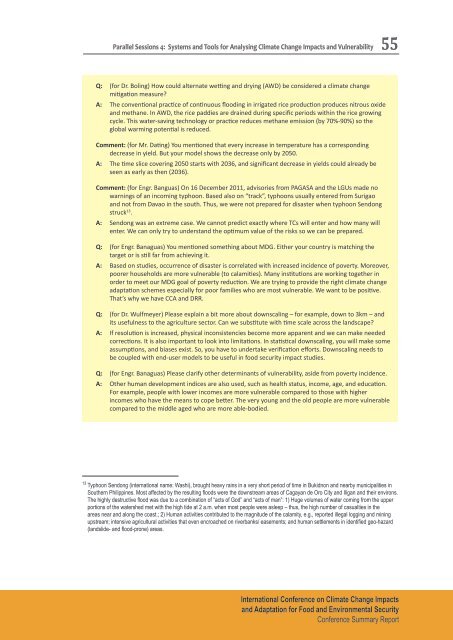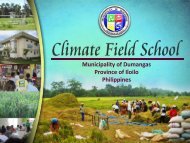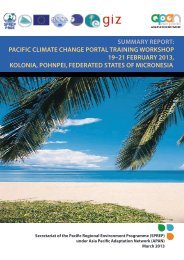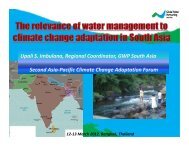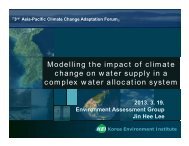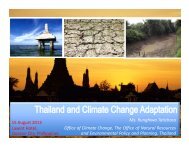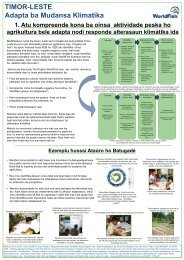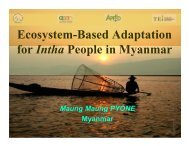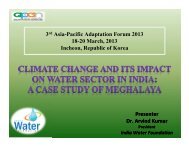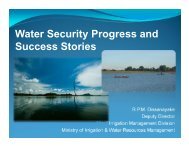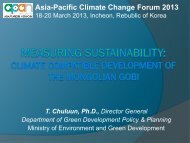PDF file (2.44 MB) - Asia Pacific Adaptation Network
PDF file (2.44 MB) - Asia Pacific Adaptation Network
PDF file (2.44 MB) - Asia Pacific Adaptation Network
You also want an ePaper? Increase the reach of your titles
YUMPU automatically turns print PDFs into web optimized ePapers that Google loves.
Parallel Sessions 4: Systems and Tools for Analysing Climate Change Impacts and Vulnerability55Q: (for Dr. Boling) How could alternate wetting and drying (AWD) be considered a climate changemitigation measure?A: The conventional practice of continuous flooding in irrigated rice production produces nitrous oxideand methane. In AWD, the rice paddies are drained during specific periods within the rice growingcycle. This water-saving technology or practice reduces methane emission (by 70%-90%) so theglobal warming potential is reduced.Comment: (for Mr. Dating) You mentioned that every increase in temperature has a correspondingdecrease in yield. But your model shows the decrease only by 2050.A: The time slice covering 2050 starts with 2036, and significant decrease in yields could already beseen as early as then (2036).Comment: (for Engr. Banguas) On 16 December 2011, advisories from PAGASA and the LGUs made nowarnings of an incoming typhoon. Based also on “track”, typhoons usually entered from Surigaoand not from Davao in the south. Thus, we were not prepared for disaster when typhoon Sendongstruck 13 .A: Sendong was an extreme case. We cannot predict exactly where TCs will enter and how many willenter. We can only try to understand the optimum value of the risks so we can be prepared.Q: (for Engr. Banaguas) You mentioned something about MDG. Either your country is matching thetarget or is still far from achieving it.A: Based on studies, occurrence of disaster is correlated with increased incidence of poverty. Moreover,poorer households are more vulnerable (to calamities). Many institutions are working together inorder to meet our MDG goal of poverty reduction. We are trying to provide the right climate changeadaptation schemes especially for poor families who are most vulnerable. We want to be positive.That’s why we have CCA and DRR.Q: (for Dr. Wulfmeyer) Please explain a bit more about downscaling – for example, down to 3km – andits usefulness to the agriculture sector. Can we substitute with time scale across the landscape?A: If resolution is increased, physical inconsistencies become more apparent and we can make neededcorrections. It is also important to look into limitations. In statistical downscaling, you will make someassumptions, and biases exist. So, you have to undertake verification efforts. Downscaling needs tobe coupled with end-user models to be useful in food security impact studies.Q: (for Engr. Banaguas) Please clarify other determinants of vulnerability, aside from poverty incidence.A: Other human development indices are also used, such as health status, income, age, and education.For example, people with lower incomes are more vulnerable compared to those with higherincomes who have the means to cope better. The very young and the old people are more vulnerablecompared to the middle aged who are more able-bodied.13 Typhoon Sendong (international name: Washi), brought heavy rains in a very short period of time in Bukidnon and nearby municipalities inSouthern Philippines. Most affected by the resulting floods were the downstream areas of Cagayan de Oro City and Iligan and their environs.The highly destructive flood was due to a combination of “acts of God” and “acts of man”: 1) Huge volumes of water coming from the upperportions of the watershed met with the high tide at 2 a.m. when most people were asleep – thus, the high number of casualties in theareas near and along the coast.; 2) Human activities contributed to the magnitude of the calamity, e.g., reported illegal logging and miningupstream; intensive agricultural activities that even encroached on riverbanks/ easements; and human settlements in identified geo-hazard(landslide- and flood-prone) areas.International Conference on Climate Change Impactsand <strong>Adaptation</strong> for Food and Environmental SecurityConference Summary Report


